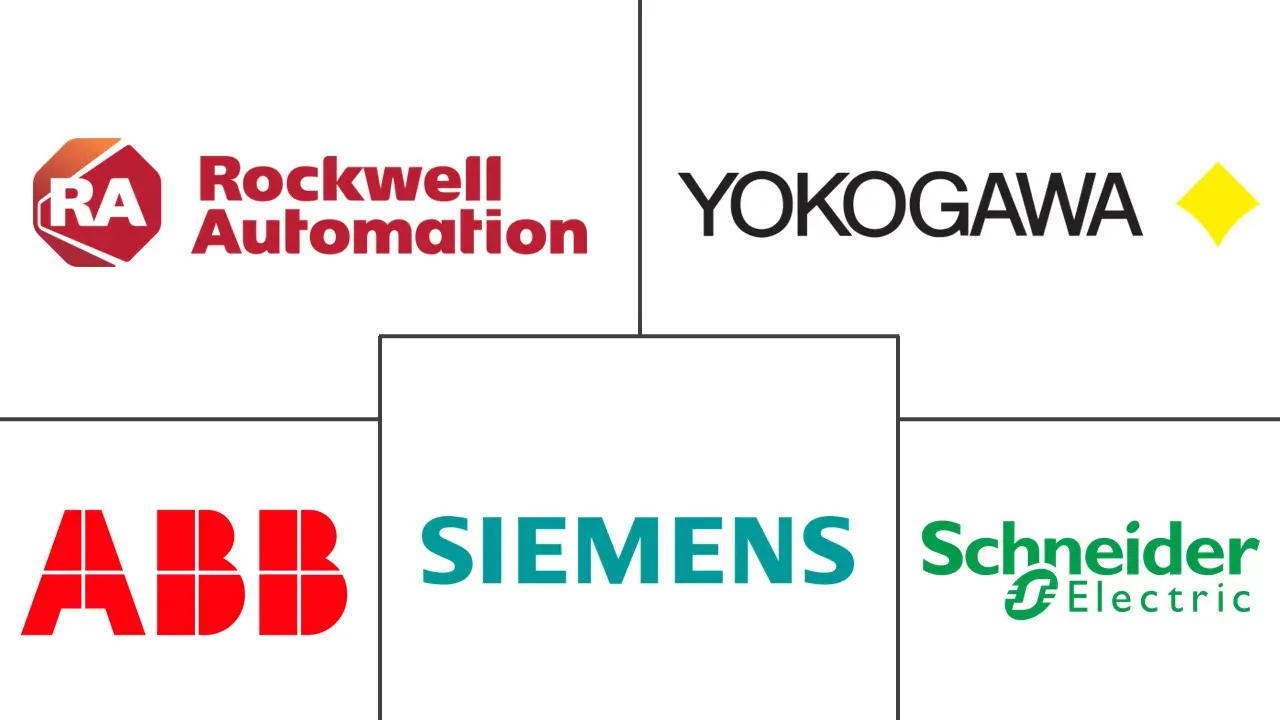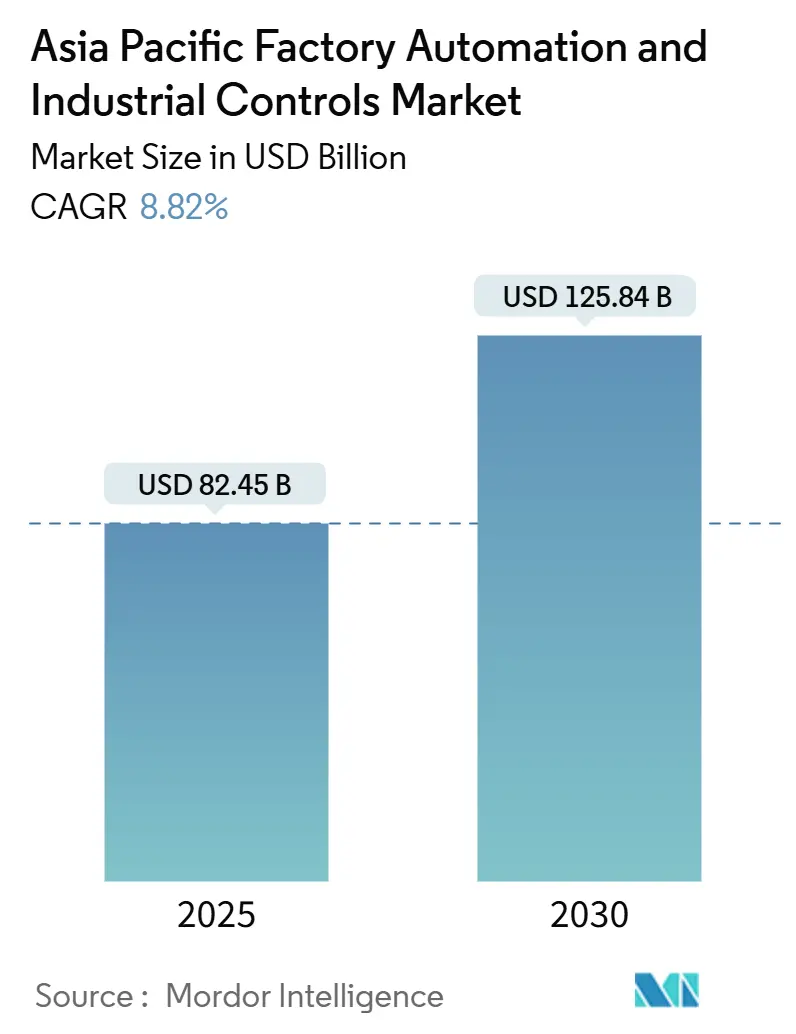
Asia Pacific Factory Automation And Industrial Controls Market Analysis by Mordor Intelligence
The Asia Pacific Factory Automation And Industrial Controls Market size is estimated at USD 82.45 billion in 2025, and is expected to reach USD 125.84 billion by 2030, at a CAGR of 8.82% during the forecast period (2025-2030).
- The primary factors supporting the studied market's growth are the ever-increasing industrialization rate, the growing adoption of advanced robotics, automation, and connected technologies, and the significant growth of major regional economies.
- The Asia-Pacific market for factory automation and industrial control systems is predominantly propelled by the heightened emphasis on improving operational efficiencies and minimizing production costs across diverse industry sectors. Manufacturing holds a prominent position in the Asia-Pacific region, and China's economy, as a major contributor, is experiencing a rapid shift due to escalating labor expenses and the waning sustainability of the traditional migrant worker model. These trends have compelled the economy to embrace automation as an integral component of their manufacturing operations.
- The market is expected to experience growth in the coming years due to increased investment and ongoing development in the manufacturing sector. The automotive, aerospace, and heavy engineering industries are increasingly adopting digitalization and transforming their manufacturing processes. Indonesia, a prominent industrial manufacturer, highly adopts automation in its industries. Manufacturing contributes significantly to a country's GDP, with Indonesia's manufacturing sector contributing over 19 percentage of the country's GDP in 2024, the most significant contributor to the nation's economy. The robust manufacturing activities in Indonesia and Malaysia are expected to drive demand for the studied market.
- Moreover, the rising adoption of Industrial robots is expected to drive the market across several nations like India, Korea, Japan, and others. Several governments in the APAC are constantly establishing various steps to push the adoption of robotic technology across multiple industries in the region. For instance, The Ministry of Science, Technology, and Innovation (MOSTI) in Malaysia has announced its objective to attain a ratio of 195 robots per 10,000 human workers by 2030. This initiative is intended to facilitate companies in meeting the growing demand and exploiting new market opportunities, leading to increased revenue and profits.
- The Internet of Things (IoT) has become a pivotal component in the implementation of new technological strategies for development, production, and logistics, commonly referred to as smart factory automation. This has led to an increased adoption of industrial automation in the region. The Japanese government has approved a plan called the 'Rebirth of Japan,' which aims to strengthen the manufacturing sector by targeting the development of USD 1.3 trillion. It is anticipated that by 2023, companies in the industrial sector could generate revenues of up to USD 490 billion due to Industry 4.0.
- Additionally, India is projected to emerge as a prominent region driving the market's growth. The Indian market is poised to experience substantial expansion owing to the rising need for energy efficiency and productivity in manufacturing operations, the "Make in India" campaign, advancements in digital technologies such as the Internet of Things (IoT) and Artificial Intelligence (AI), the presence of a skilled workforce, and increased competitiveness. Numerous vendors consistently invest in the region to augment their market position and maintain a competitive advantage.
- However, its high installation and maintenance cost prevents large-scale adoption of automation and industrial control solutions by small and medium-scale companies in the region. The ongoing trade disputes, especially with China, are also among the major challenging factors for the studied market.
Asia Pacific Factory Automation And Industrial Controls Market Trends and Insights
Automotive Industry to Drive the Market Growth
- The automotive industry plays a prominent role in the Asia Pacific factory automation and industrial controls market, holding a significant share. Automakers are increasingly automating their production facilities to ensure precision and productivity. Moreover, the rising popularity of electric vehicles (EVs) is anticipated to boost the demand for automation and industrial control solutions in the automotive sector. This shift towards electrification is driven by government initiatives and growing public awareness, which are expected to fuel the demand for EVs in the foreseeable future.
- For instance, the automotive industry in India is anticipated to experience a significant adoption of market solutions. As per the India Brand Equity Foundation (IBEF), the Indian automotive sector aims to augment vehicle exports by five times by 2026. In the fiscal year 2022, the total automobile exports from India amounted to 5,617,246. Furthermore, the Indian government expects the vehicle industry to receive domestic and foreign investments worth USD 8-10 billion by 2023, rapidly increasing manufacturing units. This presents numerous opportunities for the market in the country. For instance, in January 2023, MG Motor India invested USD 100 million to expand its capacity, with a 70 percentage growth target for 2023. Such initiatives are expected to drive the demand for various automated solutions.
- Moreover, The SCADA system is vital in contemporary Industrial Automation solutions. It has become integral to the operational laboratory framework for conducting physical tests on newly developed technological solutions for hybrid electric vehicle (HEV) driving systems. The projected extensive utilization of SCADA in electric vehicles (EVs) is anticipated to result in substantial market expansion, propelled by the growing adoption of EVs in the region and government initiatives to promote the EV sector.
- The rising vehicle sales in the region are further expected to drive the demand for the market. For instance, as per the Malaysian Automotive Association (MAA), the total industry volume (TIV) of new vehicle sales in Malaysia witnessed a significant surge of 32.7 percentage in May, reaching 61,795 units from 46,583 units in April 2023. Additionally, the year-to-date total production volume (TPV) of 304,484 units was 18 percentage higher than in 2022. These commendable manufacturing and sales capabilities are expected to encourage the adoption of automation technologies in production facilities.
- India is a significant automobile exporter and is expected to experience substantial export growth in the forecast period. The Government of India has implemented various initiatives, such as the scrappage policy, Automotive Mission Plan 2026, and production-linked incentive scheme, to establish India as a prominent player in the two-wheeler and four-wheeler market. To achieve this, automotive industry market players are incorporating new processes and technologies. For example, Hyundai Motor India Ltd (HMIL) has announced the adoption of futuristic technologies and advanced Manufacturing 4.0 at the Hyundai Mega Manufacturing Plant, which includes over 590 Generation 4 robots.
- Furthermore, as per the OICA report, China holds the top position as the largest market for passenger cars globally. China accounts for more than half of the passenger car sales in the Asia-Pacific region and over a third of the world's sales. The Asia-Pacific region comprises significant markets like Japan, India, and South Korea, which collectively sold over a million passenger cars in 2023. OICA data reveals that China sold over 26 million passenger cars in 2023, making it the largest market in the Asia-Pacific region. India secured the second position in the region with nearly 4.1 million unit sales in 2023. These capabilities are expected to attract investments in the region and drive the adoption of automated technologies in their manufacturing plants.
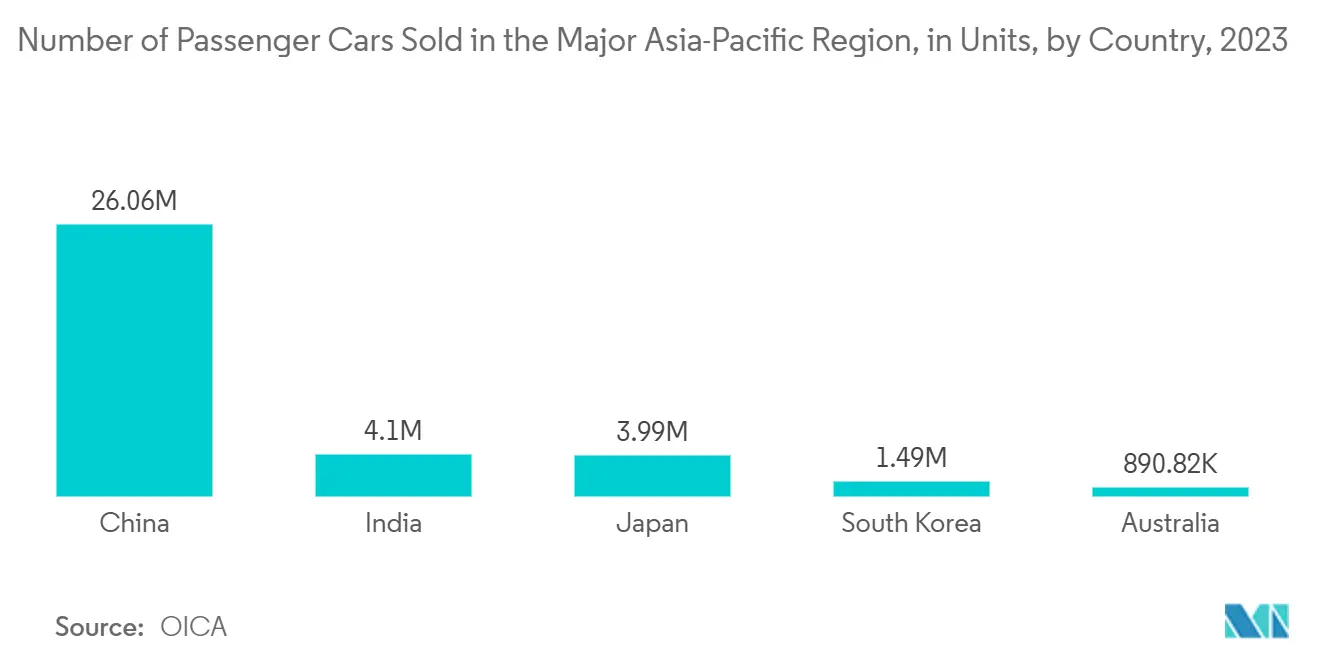
South Korea is Expected to Contribute a Significant Market Share
- South Korea is a significant industrial producer that extensively employs automation in its industries. The manufacturing sector plays a key role in a country's GDP. As per the Bank of Korea, South Korea's manufacturing sector generated a real GDP of KRW 524.45 trillion (USD 392 billion) in 2022-2023, indicating growth from the previous year. The substantial manufacturing activities in South Korea are expected to drive the demand for the studied market. Additionally, the rapid advancement in automation technology by market vendors in the region has resulted in frequent variations in product ranges or software functionalities.
- Moreover, in January 2023, the International Federation of Robotics released the World Robotics 2022 report, which revealed that South Korea had achieved the highest global ranking for robot density. In 2023, the country boasted 1,000 industrial robots per 10,000 manufacturing employees, a figure seven times higher than the worldwide average of 141 robots per 10,000 employees. The increasing integration of robotics across various industries in the region is anticipated to propel the market forward substantially.
- For instance, as per the Ministry of Transport, South Korea intends to implement safety protocols and an insurance structure to facilitate the introduction of Level 4 autonomous vehicles nationwide by 2024. Furthermore, recently, Motional forged a ten-year partnership with Uber Technologies Inc., an American ride-hailing firm, to supply Hyundai's IONIQ 5 self-driving robot taxis. These endeavors are anticipated to propel the market's growth.
- Moreover, the rising investments in the region's automotive industry are expected to create a significant demand for adopting automated technologies. For instance, in July 2023, the Kia manufacturing plant in Gwangju exhibited its automated operations via a seamless production line of pressing machines responsible for manufacturing automotive body panels. Additionally, the production facility has successfully integrated AI fencing systems throughout all workshops to promptly halt the automated process upon detecting human presence within the operational zones, thereby preventing potential accidents.
- The increasing demand for sustainable energy sources strengthens the need for Automation and Industrial control in the power generation sector. The South Korean Government supports the growth of renewable energy sources and aims to increase the proportion of energy derived from renewables to 35 percentage by 2040. For instance, Hyundai Energy Solutions, a solar power subsidiary of HD Hyundai Co., plans to begin large-scale production of ultra-high-efficiency solar panels by 2026. Due to their extensive use in the solar industry, these investments are expected to create opportunities for various Industrial Control Systems (ICS), such as SCADA.
- Furthermore, the burgeoning healthcare sector and the growing utilization of automated technologies are anticipated to propel the market further. The healthcare sector is utilizing technological advancements in automation and robotics to improve the effectiveness and accuracy of their operations, such as filling, packaging inspection, and other tasks. In April 2023, Hyundai Motor Company signed a memorandum of understanding with Asan Medical Center to donate its medical wearable robot, X-ble MEX, for patient support and collaborative research. These endeavors to provide diverse mobility platforms using assistive robotic technology are expected to drive the market forward.
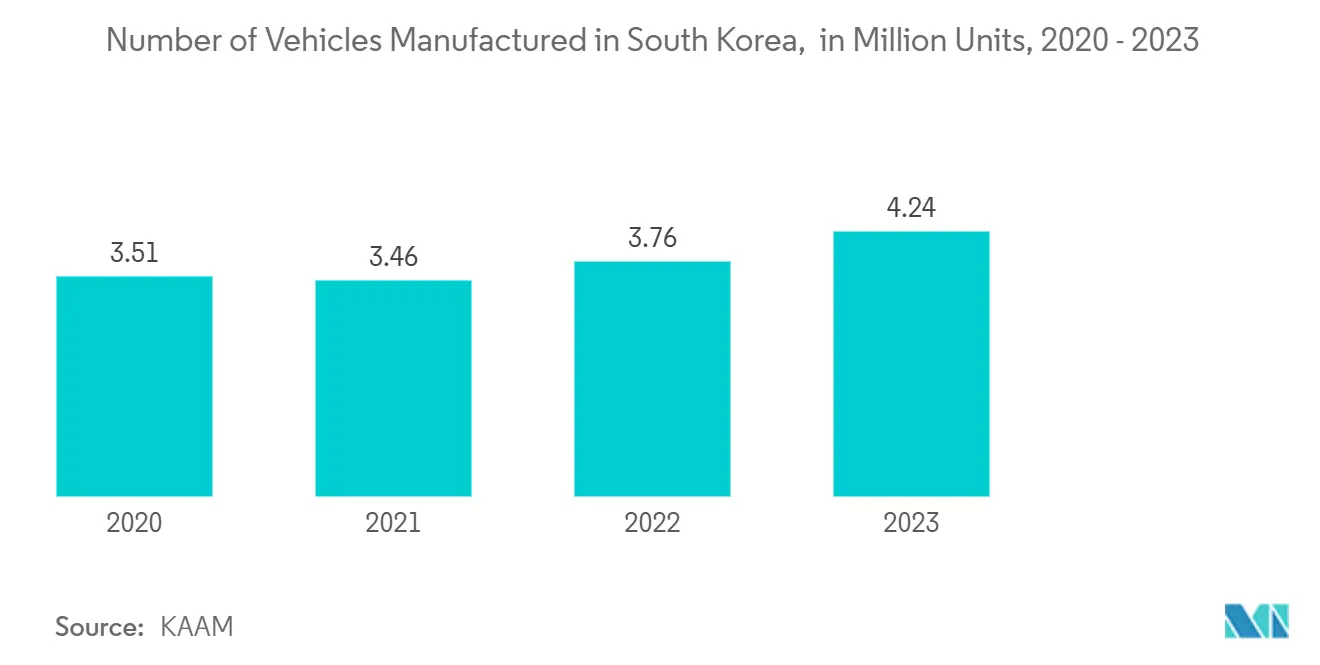
Competitive Landscape
The Asia Pacific factory automation and industrial controls market is competitive due to the presence of several market players. The increasing demand is also attracting new players in the market, further driving the competitiveness among the players. Major vendors are involved in product development and strategic activities such as partnerships, mergers, and acquisitions. Some key market players include ABB Ltd., Siemens AG, Schneider Electric SE, and Yokogawa Corporation.
The Asia Pacific Factory Automation and Industrial Controls Market is set for significant growth driven by technological advancements, labor market dynamics, and supportive government policies. As industries increasingly adopt automation to enhance efficiency and productivity, the region is likely to solidify its position as a global leader in industrial innovation.
Asia Pacific Factory Automation And Industrial Controls Industry Leaders
-
ABB Limited
-
Siemens AG
-
Schneider Electric SE
-
Yokogawa Electric Corporation
-
Rockwell Automation Inc.
- *Disclaimer: Major Players sorted in no particular order
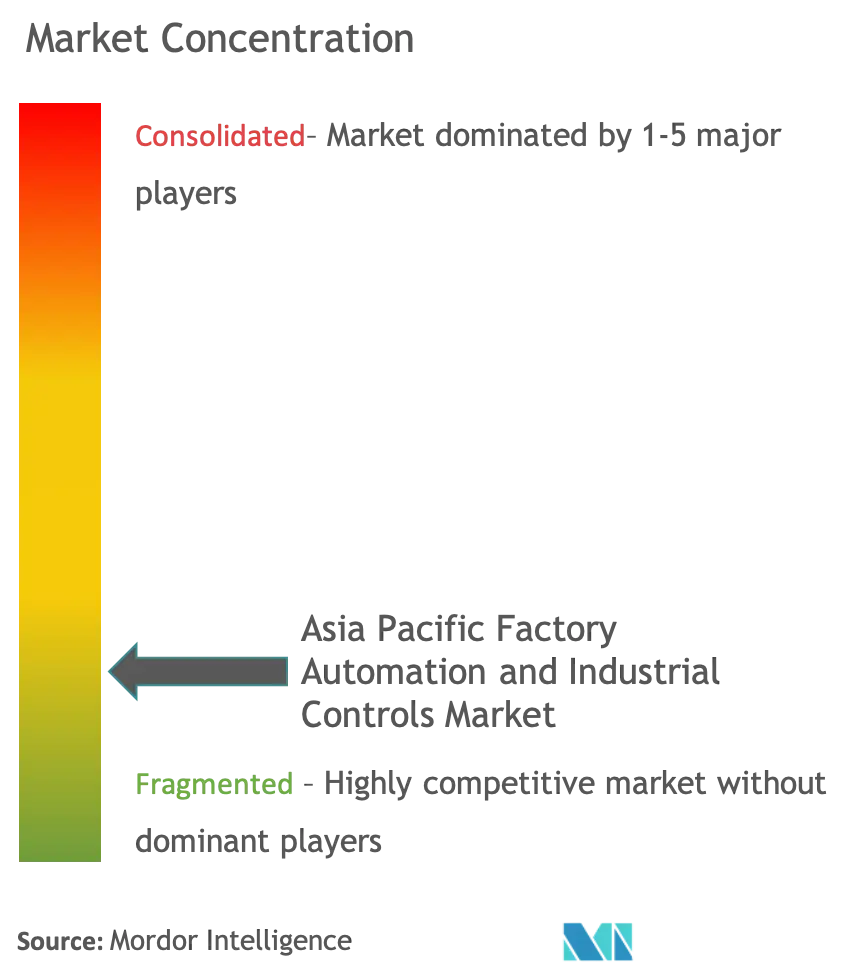
Recent Industry Developments
- September 2024: ABB has signed a joint development agreement with US company Energy Control Technologies (ECT) to co-design and deliver an integrated turbomachinery controls solution which can be configured, operated and maintained within the ABB Ability System 800xA distributed control system (DCS).
- April 2024: Rockwell Automation, Inc., the world's largest company dedicated to industrial automation and digital transformation, launched the FLEXLINE 3500, a new low voltage motor control center (MCC) for IEC markets globally. With this motor control center, manufacturers can unlock production data and increase uptime and productivity through a portfolio of smart products.
Asia Pacific Factory Automation And Industrial Controls Market Report Scope
Factory automation and industrial controls use automation solutions such as robotics and control systems, such as computers, relays, and information technologies to handle different processes and machinery in an industry to replace manual intervention either partially or completely. It is the second step beyond mechanization in the scope of industrialization.
The Asia Pacific Factory Automation and Industrial Controls Market is segmented by type (industrial control systems, field devices), end-user industry (oil and gas, chemical and petrochemical, power and utilities, food and beverages, automotive, pharmaceutical), and country (China, India, Japan, South Korea, Rest of Asia-Pacific). The market sizes and forecasts are provided in terms of value (USD) for all the above segments.
| Industrial Control Systems | Distributed Control System (DCS) |
| PLC (Programmable Logic Controller) | |
| Supervisory Control and Data Acquisition (SCADA) | |
| Product Lifecycle Management (PLM) | |
| Human Machine Interface (HMI) | |
| Manufacturing Execution System (MES) | |
| Enterprise Resource Planning (ERP) | |
| Other Industrial Control Systems | |
| Field Devices | Machine Vision Systems |
| Robotics (Industrial) | |
| Sensors and Transmitters | |
| Motors and Drives | |
| Other Field Devices |
| Oil and Gas |
| Chemical and Petrochemical |
| Power and Utilities |
| Food and Beverages |
| Automotive |
| Pharmaceutical |
| Other End-user Industries |
| China |
| India |
| Japan |
| South Korea |
| Rest of Asia Pacific |
| By Type | Industrial Control Systems | Distributed Control System (DCS) |
| PLC (Programmable Logic Controller) | ||
| Supervisory Control and Data Acquisition (SCADA) | ||
| Product Lifecycle Management (PLM) | ||
| Human Machine Interface (HMI) | ||
| Manufacturing Execution System (MES) | ||
| Enterprise Resource Planning (ERP) | ||
| Other Industrial Control Systems | ||
| Field Devices | Machine Vision Systems | |
| Robotics (Industrial) | ||
| Sensors and Transmitters | ||
| Motors and Drives | ||
| Other Field Devices | ||
| By End-user Industry | Oil and Gas | |
| Chemical and Petrochemical | ||
| Power and Utilities | ||
| Food and Beverages | ||
| Automotive | ||
| Pharmaceutical | ||
| Other End-user Industries | ||
| By Country | China | |
| India | ||
| Japan | ||
| South Korea | ||
| Rest of Asia Pacific | ||
Key Questions Answered in the Report
How big is the Asia Pacific Factory Automation And Industrial Controls Market?
The Asia Pacific Factory Automation And Industrial Controls Market size is expected to reach USD 82.45 billion in 2025 and grow at a CAGR of 8.82% to reach USD 125.84 billion by 2030.
What is the current Asia Pacific Factory Automation And Industrial Controls Market size?
In 2025, the Asia Pacific Factory Automation And Industrial Controls Market size is expected to reach USD 82.45 billion.
Who are the key players in Asia Pacific Factory Automation And Industrial Controls Market?
ABB Limited, Siemens AG, Schneider Electric SE, Yokogawa Electric Corporation and Rockwell Automation Inc. are the major companies operating in the Asia Pacific Factory Automation And Industrial Controls Market.
What years does this Asia Pacific Factory Automation And Industrial Controls Market cover, and what was the market size in 2024?
In 2024, the Asia Pacific Factory Automation And Industrial Controls Market size was estimated at USD 75.18 billion. The report covers the Asia Pacific Factory Automation And Industrial Controls Market historical market size for years: 2019, 2020, 2021, 2022, 2023 and 2024. The report also forecasts the Asia Pacific Factory Automation And Industrial Controls Market size for years: 2025, 2026, 2027, 2028, 2029 and 2030.
Page last updated on:
Asia Pacific Factory Automation And Industrial Controls Market Report
Statistics for the 2025 Asia Pacific Factory Automation And Industrial Controls market share, size and revenue growth rate, created by Mordor Intelligence™ Industry Reports. Asia Pacific Factory Automation And Industrial Controls analysis includes a market forecast outlook for 2025 to 2030 and historical overview. Get a sample of this industry analysis as a free report PDF download.
